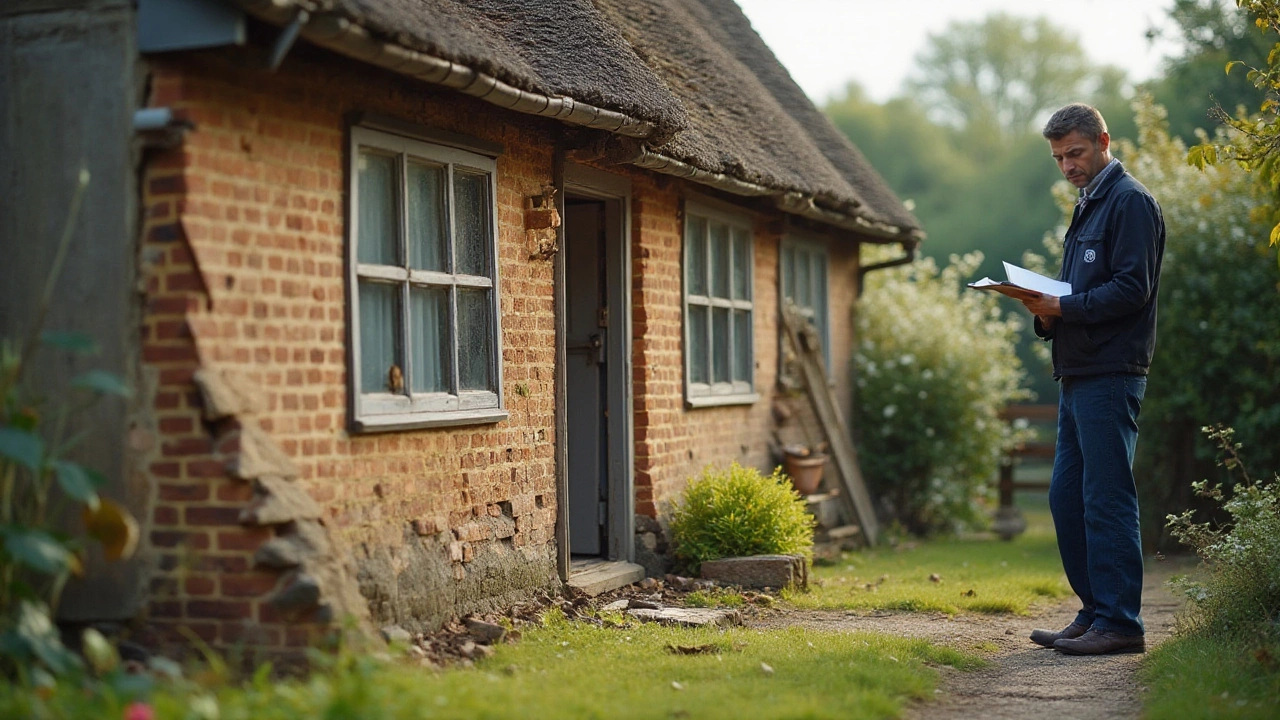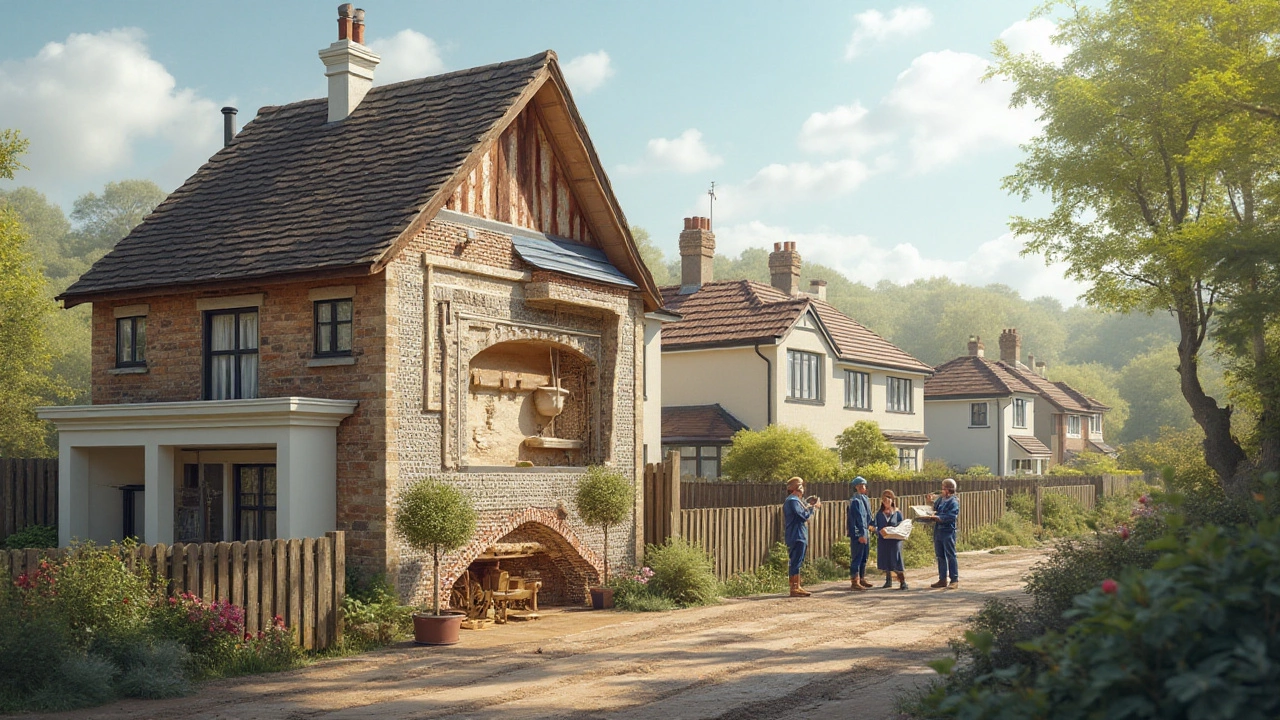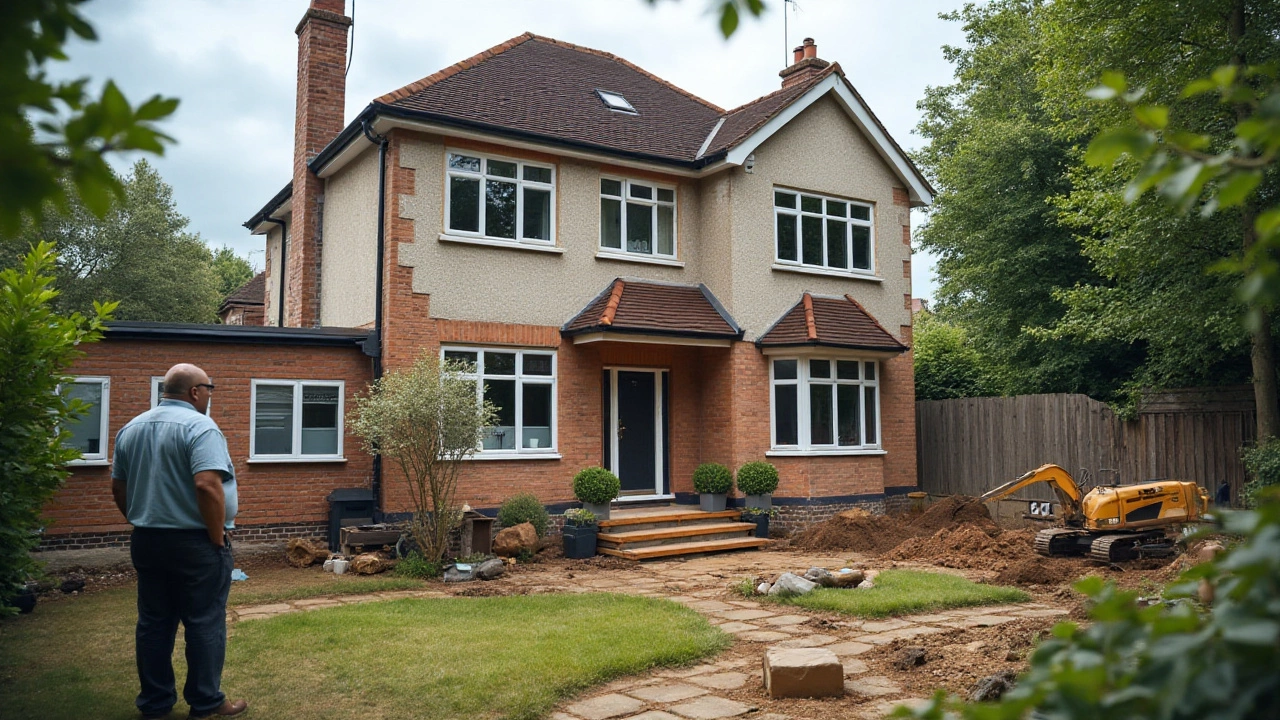
When it comes to homes, the foundation is literally where everything stands. But what happens when this building block begins to crumble? Are cracks and shifts sounding an alarm too late, or is there still hope for repair?
For homeowners, a shaky foundation can be a source of anxiety, conjuring visions of irreparable damage and spiraling costs. Yet, with advances in repair technology and an array of available techniques, many homes with foundation issues can be saved.
Through a deeper understanding of the early signs, repair strategies, and preventive measures, saving a home with a bad foundation becomes more than just a possibility; it becomes a practical reality. This guide is here to walk you through the process, helping you identify potential issues before they escalate and exploring the myriad ways to reinforce your home's stability.
- Understanding Foundation Problems
- Signs Your Home’s Foundation Is in Trouble
- Exploring Repair Options
- The Cost of Foundation Repairs
- Preventive Measures and Maintenance
Understanding Foundation Problems
The foundation of a home is a crucial component that essentially holds everything together. Despite this significance, many homeowners are unaware of what lies beneath their floors. A foundation problem refers to any issue that affects the structural stability and integrity of a building. It can manifest in numerous ways, such as cracks in the walls or floors, doors and windows that refuse to close properly, uneven floors, or gaps around the window frames. These issues might seem minor at first, probably easy to brush off as mere signs of an aging structure, but they can be harbingers of much larger, costly repairs if left unaddressed.
There are two primary types of foundation issues: settlement and upheaval. Settlement occurs when parts of the foundation sink into the ground due to unstable soil conditions, moisture changes, or improper construction. This sinking action can lead to an uneven foundation where one side of the home is lower than the other. On the flip side, upheaval refers to the upward movement of the foundation, usually caused by soil expansion, often resulting from excessive moisture or increased pressure from tree roots. Both conditions can wreak havoc on a home's structural integrity, leading to extensive damage that demands immediate attention.
"A house is only as strong as its foundation," asserts engineering expert Dr. Leslie Cho from the Institution of Structural Engineers. "Without a solid base, every component above it is at risk."In tackling foundation concerns, it's critical to identify the root cause of the problem. Understanding factors like soil composition and the geological conditions of the home's location are vital. Most home foundation problems arise from water-related damage. Excessive moisture or poor drainage allows ground soil to expand and contract with seasonal shifts, leading to movement beneath the home.
Soil type plays a significant role too. Expansive clay soils, common in many areas, absorb water, swell, and then shrink when dry, creating a continuous cycle of pressure that can crack a foundation. However, homes built on sandy soils often face erosion-related issues, because sandy soil drains quickly and doesn’t provide as much stability. Recognizing these underlying causes can aid in diagnosing the specific problems a foundation is facing.
Foundation repair is vital for maintaining a home’s structural integrity, and understanding the nature of foundation issues is the first step in that process. Solutions vary based on the problem: from piers to lift and support the home, to simple patching of visible cracks. Equipped with this knowledge, homeowners can marry practical intervention with proactive maintenance, securing their investments for the long haul.
Signs Your Home’s Foundation Is in Trouble
Discovering potential warning signs in a home’s foundation is crucial in safeguarding the structural integrity of your dwelling. A strong and stable foundation is the core that holds everything up, so even the smallest issues should not be dismissed lightly. To start, watch out for unusual occurrences around your house. Cracks are perhaps the most recognizable indicators that something might be amiss. These can appear in the walls, ceilings, and especially around windows and door frames. Not all cracks are created equal—vertical cracks might not pose a significant threat, whereas horizontal ones could signal more serious foundation movement requiring immediate attention.
Look closely at the fit and function of doors and windows. Misaligned doors and windows that suddenly stick or won’t shut properly might indicate an uneven foundation. Pay heed to sagging floors or ceilings as well, as these could arise from shifting beneath the surface. Moreover, investigate your basement or crawlspace for moisture. A damp basement may not just be an isolated issue; water pooling against a foundation can introduce invasive moisture and cause soil expansion or contraction.
Another telltale sign involves external clues such as water drainage patterns not diverting properly away from your home. Look for obvious settling in your yard, particularly around the base of your house. Puddles forming after a rainstorm where they shouldn't could be a sign that water isn't being guided safely. A sloping or bulging foundation wall should never be taken lightly, as this structural change may suggest your foundation is under abnormal stress.
Finally, foundation-related issues might also manifest subtly in your home. Keep an eye on interior decoration anomalies, like nails popping from drywall or baseboards pulling away from the wall. These hints, along with odd gaps forming where floors and walls meet, signal that the base of your house is moving, stressing elements it should not.
"The sooner you spot a problem, the more easily and affordably it can be repaired," advises expert Geoff Jensen, a renowned structural engineer from the National Foundation Repair Association. "Homeowners who educate themselves are often able to mitigate larger issues with small preventive actions."

Exploring Repair Options
When faced with the daunting prospect of foundation repair, homeowners often find themselves overwhelmed by the sheer variety of options available. Each method caters to different issues, meaning that understanding your specific needs is essential. Successfully diagnosing your foundation problems will guide you toward the aptly chosen repair solution. Repair approaches range from straightforward fixes like sealing small cracks to more intensive procedures involving underpinning with piers. Foundation repair remains integral to maintaining a home's structural integrity, so taking the right steps can make all the difference.
The Role of Piering and Underpinning
Piering and underpinning have long stood as two of the most common methods in foundation repairs. These techniques involve the insertion of steel or concrete piers that support the foundation by transferring the weight of the structure to deeper, more stable soil layers. For homes suffering from settling due to poor soil conditions or significant erosion, this solution offers a reliable way to ensure stability. The process, though intricate, promises long-term security, making it a preferred choice for many structural engineers.The American Society of Civil Engineers notes, "Proper underpinning can not only restore but also 'future-proof' homes against common foundation threats."
Utilizing Slab Jacking
Another versatile repair option is slab jacking, often suitable for concrete slab foundations. This method works by pumping a special grout mixture beneath the sinking foundation, effectively lifting it back into place. It's a more fitting choice for minor settling issues and when addressing cracks caused by shifts in the ground beneath lightweight structures. Slab jacking stands out for its relatively non-invasive nature and cost-effectiveness, providing homeowners with a swift and responsible solution. Evaluating slab jacking often involves understanding the underlying causes of the damage, which can also serve as a pre-emptive measure against recurring problems.Epoxy Injections for Crack Repairs
Minor cracks in basement walls or floors might not seem alarming at first glance. However, if left unattended, they can lead to substantial moisture problems and eventual structural failures. Epoxy injections serve as an excellent foundation repair technique for these smaller cracks. These injections, filled with a high-strength adhesive, bond concrete surfaces together, effectively sealing the cracks against water and pests. While primarily used for addressing aesthetic issues, they provide additional reinforcement for minor structural inconveniences, helping to prolong the lifespan of your foundation materials.The choice of repair method often depends on the severity and type of foundation issues encountered. Sometimes, a combination of these techniques might be necessary to achieve optimal results. Proactive homeowners will likely adopt a curious mindset, seeking expert opinions to ensure their homes receive the most appropriate care. With popular methods like piering, slab jacking, and epoxy injections, the chances of restoring a solid foundation increase significantly, all the while maintaining peace of mind and the safety of the home environment.
The Cost of Foundation Repairs
Dealing with a faltering foundation can undoubtedly spark a whirlwind of concerns, especially when it comes to expenses. The foundation repair costs can vary significantly depending on several factors, including the severity of the damage, the type of repair required, and the geographical location of the home. For instance, minor crack repairs might only set a homeowner back by a few hundred dollars, while extensive structural restorations involving piering can run into the tens of thousands. It's crucial to approach each situation individually, as personalized assessments by professionals often reveal unexpected complexities and cost variations. One cannot simply apply a one-size-fits-all approach when it comes to such a vital component of a house's structure.
Many factors influence the eventual cost of foundation repair, but perhaps the most crucial determining factor is the type of repair technique suitable for the specific problem. Common methods like sealing, slab jacking, or underpinning each come with their own unique set of costs and benefits. For example, chemical grouting might provide a less invasive solution with an intermediate price tag, while underpinning, although potentially costly, offers a robust, long-lasting solution for serious subsidence issues. Additionally, unforeseen complications uncovered during repairs, such as plumbing leaks or additional structural deficiencies, can also contribute to climbing costs. Thus, when considering repair options, understanding the potential financial implications and warranties of each technique is indispensable for homeowners.
Interestingly, geographic location plays a crucial role in influencing repair costs as well. Homes situated in regions with expansive soils or areas prone to earthquakes might face unique challenges that require specialized repair approaches. In Texas, where clay-rich soils expand and contract with moisture levels, homes are particularly susceptible to foundation movements, often necessitating more frequent inspections and potential interventions. In the words of Nathaniel Peck, a seasoned structural engineer, "location isn't just about real estate prices; it shapes the soil and foundation behavior under your home."
"The cost of repair is closely tied to locale-specific geological conditions and the type of soil your house rests on," he explains, emphasizing the distinctive needs of residents across varied landscapes.Such insights shed light on why a thorough understanding of local soil and weather patterns is vital when budgeting for foundation repairs.
For homeowners set to embark on the journey of foundation repair, having a roadmap of what to expect financially is crucial. Many companies offer complimentary inspections and estimates, allowing homeowners to gauge a realistic picture of potential expenses before committing to a course of action. It's essential to seek multiple opinions and quotes, as prices can vary substantially from one provider to another. Additionally, the potential availability of financing options or insurance coverage can offer a cushion for unforeseen expenses, making the daunting process slightly less burdensome. While the costs associated with foundation repairs can be significant, the peace of mind from addressing the problem head-on can be invaluable, preventing minor concerns from snowballing into irrevocable damage.

Preventive Measures and Maintenance
Keeping a home’s foundation in top shape involves a mix of vigilance and timely interventions. One of the primary keys to preventing major foundation issues is ensuring proper drainage around the home. Water is both a friend and a foe to your home's stability. Ensuring your gutters are clean and downspouts direct water at least five feet away from your home could save you from headaches. A proper slope of the landscape, ideally a six-inch drop for every ten feet, can also assist in channeling water away efficiently.
Landscaping plays a significant role too. Planting trees or shrubs too close to the house may look aesthetically pleasing but can be detrimental under the surface. Their roots seek out moisture and can disturb your home’s base significantly. Keeping a distance of at least their full growth height between the plant and your home ensures safety. It's advisable to choose smaller, non-invasive species for any plantings within ten feet of your house.
Regular monitoring of the foundation itself is crucial. Homeowners can keep an eye out for small, telltale cracks on walls and floors. Measuring these periodically helps in tracking whether they are expanding, which might require a professional evaluation. Seasonal changes can affect foundation conditions, such as soil expansion in wet conditions or contraction during drought, thereby impacting foundation health. Homeowners should stay alert to these conditions, especially after bouts of extreme weather.
"Home maintenance isn't just about catching problems early—it's about preventing them from forming in the first place," once noted renown structural engineer Fran Lebowitz, highlighting the importance of routine checks.
Temperature control within the home also plays a preventive role. Extreme humidity levels can affect the moisture content of the soil beneath. Using humidifiers or dehumidifiers as needed helps maintain balance, thereby aiding structural integrity. It's a simple yet effective method to combat one of the natural adversaries of foundations: fluctuating moisture levels. Remember, balanced environmental conditioning helps in maintaining balanced soil conditions.
A rarely considered, yet proactive step is reviewing and managing the load-bearing aspects of the house. Overloads, be it in one section of the house due to remodeling or additions can strain the foundation. Engaging with a structural engineer before any major renovation keeps the foundation safe from unexpected pressure shifts. This is insurance of sorts, avoiding structural stress that might otherwise lead to costly repairs down the road.
Finally, forming a good relationship with local experts in foundation repair can be invaluable. Knowing who to call when there's an issue, and keeping up with modern techniques and materials can often be the difference between long-term security and unforeseen expenses. Many companies offer free inspections and provide detailed insights without an immediate sales pitch. Thus, homeowners should not shy away from taking professional advice, ensuring the foundation of their dreams remains rock solid.




